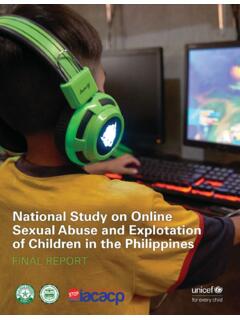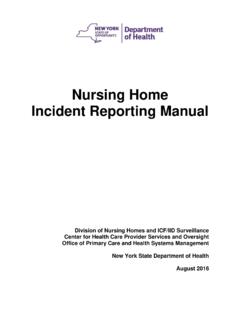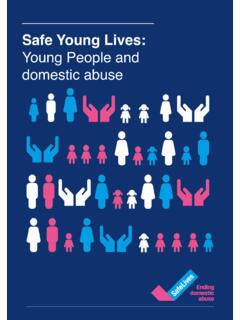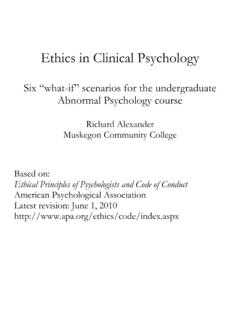Transcription of PSEA Basics Training Guide - InterAction
1 PSEA Basics Training Guide Preventing and Responding to sexual Exploitation & abuse (PSEA). Three simple to use Training modules: PSEA Basics Reporting Systems Community Based Complaints Mechanisms December 2013. Forward sexual exploitation and abuse (SEA) of beneficiaries by aid workers is a serious concern of the humanitarian community, and represents one of the most egregious failures of protection. As organizations dedicated to alleviating harm and respecting and honoring the dignity and integrity of everyone, InterAction members have an obligation and responsibility to perform in a manner that is consistent with the fundamental principles of human rights. Given this, we must remain at the forefront of efforts to prevent SEA. The InterAction PSEA Basics Training Guide was developed to provide NGOs with three simple to use Training modules which focus on the PSEA fundamentals and can be easily adaptable to many locations. The methodology across the three modules is designed to engage participants through discussions and group work.
2 The content of the modules covers: 1) understanding SEA and upholding the Code of Conduct; 2) the importance of having a well-functioning reporting system; and 3) the basic elements that make up a community-based complaints mechanism. Much of the content in this manual is drawn from guidance developed by the Building Safer Organizations initiatives now housed within the Humanitarian Accountability Partnership, and other documents developed by the IASC PSEA Task Force. All resource materials can be found online: This Training Guide was developed by Daisy Francis for an InterAction project funded by the Department of State's Bureau for Population, Refugees, and Migration. InterAction PSEA Training Page | 1. Table of Contents Module 1: PSEA Basics .. 3. Facilitation Guide .. 3. Session 1: Understanding 4. Session 2: The Six Core Principles/Agency Code of Conduct .. 5. Session 3: Recognizing Code of Conduct Violations .. 6. Handout 1: Understanding sexual Exploitation and abuse (SEA).
3 8. Handout 2: Code of Conduct Exercise .. 9. Module 2: Reporting Systems ..10. Facilitation Guide ..10. Session 1: Overview of Reporting systems .. 11. Session 2: Agency Reporting 11. Session 3: Barriers to Reporting .. 11. Handout 1: Internal and External Reporting .. 13. Module 3: Community Based Complaints Mechanisms ..14. Facilitation Guide ..14. Session 1: Four Characteristics of an effective 15. Session 2: Ten Principles for a CBCM .. 15. Session 3: Six Steps in Developing a CBCM .. 15. Handout 1: Four Characteristics of an Effective Complaints Mechanism .. 16. Handout 2: Ten Principles for Establishing a CBCM .. 17. Handout 3: Steps in Developing a CBCM .. 19. PSEA Training Glossary ..20. InterAction PSEA Training Page | 2. Module 1: PSEA Basics Facilitation Guide Purpose: Module 1 is designed to engage participants through simple exercises to understand what actions and behaviors constitute sexual exploitation and abuse (SEA) of beneficiaries and that they develop an appreciation of the personal stake they have in upholding their Agency's Code of Conduct.
4 Training Audience: This module can be used as an introductory Training unit with field-based new hires [front-line staff, volunteers, etc.] and also as a quick refresher course. The unit can also be inserted into focus-group discussions with beneficiaries. For discussion with beneficiaries, omit Session 2, as the latter is relevant to humanitarian staff. Rather, focus on explaining to beneficiaries about their right to be free from SEA and the good conduct that they should expect from staff [ explain that your Agency has a strict standard regarding Staff Conduct and that beneficiaries have a right to expect this level of good conduct and therefore, a right to bring forward any concerns where staff are not upholding the expected conduct]. Timing: Depending on the audience, this module may take 60 minutes [ senior management] or go to 180 minutes [programming staff; beneficiaries; partners]. A key part of tailoring this Training is assessing the audience's needs and then deciding how much time to devote to each of the three sessions in this module.
5 Materials: If needed, the Agency Code of Conduct and Handout 2 should be translated into the relevant local language. If this is not possible, it will be important to have a co-facilitator who can provide oral translations of these materials, for those who are not able to work in English, if you the trainer cannot do this. Agenda: Session 1: Understanding SEA. Opening Discussion Handout 1: Definitions Page Discussion Session 2: The Six Core Principles/Code of Conduct (CoC). Presentation of your agency's CoC. Compare to IASC Principles Discussion Session 3: Code of Conduct Violations: Illustrative examples Handout 2: Brief scenarios Small Group Work Plenary Discussion InterAction PSEA Training Page | 3. Session 1: Understanding SEA. In this opening session participants will gain a better understanding of what is meant by SEA and related terms. Participants will be given a brief introduction to the terminology and will receive a handout with the various definitions. Ask participants what they think SEA means.
6 Make sure you create a comfortable setting where participants feel safe to talk about this sensitive issue. Do not be judgmental. It is culturally appropriate to talk about SEA and of our responsibility to act and behave in a way that is fully respectful of the dignity of the beneficiaries. Read aloud [or ask someone in the room to read aloud] the formal definition of sexual exploitation. Then ask for suggestions of examples of this. Below are ideas to share with the group. Examples of sexual Exploitation A head teacher at a school, employed by an NGO, who refuses to allow a displaced child to enter his school unless her mother sleeps with him. A UN driver who regularly provides rides in the official UN vehicle to village schoolboys travelling to school in a neighboring town, in exchange for him taking photographs of them posing naked. The female boss of an NGO office, refusing to give employment to a young man applying to be a kitchen server unless he sleeps with her. (Remember: even if the young man refuses to sleep with her, if she attempts to abuse her position by making such a request, she is guilty of sexual exploitation It also includes situations where a staff member or related personnel facilitate SEA, while not directly engaging in the abuse or exploitation.)
7 For example: A peacekeeper is requested by his superior officer to encourage a female member of the local population to engage in a sexual relationship with him in exchange for small sums of money. Read aloud the definition of sexual abuse . Again, ask the group to offer examples of this. Examples of sexual abuse A refugee, who is employed as an incentive worker by WFP, lures a female refugee collecting food to a deserted warehouse and rapes her, announcing that he will tell her husband they are having an affair if she reports the case. A local Red cross worker touches a 6-year-old girl inappropriately while playing with her as part of a psycho-social intervention. Solicitation of a prostitute. Ask participants what are our responsibilities vis- -vis beneficiaries. These are some of the key points you want to underline throughout the discussion. 1. We always work in areas that are affected by conflicts, disasters and poverty, where people will do everything to access food or get some services.
8 2. We have power. By driving our big white cars and distributing assistance we are perceived as people who have power. There is always a power imbalance between NGO workers and beneficiaries. It is easy to misunderstand and take advantage of beneficiaries' vulnerability. InterAction PSEA Training Page | 4. 3. Make sure participants understand the difference between SEA of beneficiaries, wider GBV. issues and sexual harassment. 4. In many cases our staff do not perceive engaging with prostitutes as SEA. They feel there is a consent and clarity when it comes to the terms of the transaction. It is a service they pay for and no one girls or boys - is forced to engage. Remind them of the power imbalance and that we work in highly vulnerable context where people will do anything to survive and feed their families. Many times staff will use as a justification to engage with prostitutes the fact they are away from families and they have biological needs. Ask what systems and procedures does your agency have in place to address the issue of prolonged separation from families.
9 ( R&R). 5. Remind participants that they are on duty 24/7 [ there is no time when you are not bound by it]. And that they are required to uphold the obligations, when it comes to SEA, even outside their official working hours. At the end of Session 1, hand out the Definitions page, as they will need it for the next Session. Session 2: The Six Core Principles/Agency Code of Conduct This session will introduce the IASC's Six Core Principles and give facilitators a chance to match it against their own Agency's Code of Conduct. The goal is to outline the obligations of humanitarian staff as a result of signing their Code of Conduct. This session may be omitted if the primary audience for the Training is beneficiaries or community members. Start the session by asking the group if they have signed the Code of Conduct? Ask those that have signed it to raise their hands. Now, ask those that have not signed the Code of Conduct to raise their hands. Ask those that have answered YES to signing' if they remember what is in the Code of Conduct.
10 Now, hand out copies of your Agency's Code of Conduct and ask if they remember signing it [only in sessions with agency staff]. These are some key messages you could include during your presentation. At this stage participants should have sufficient understanding of what SEA is and that the Code of Conduct is one of the tools the humanitarian community has to prevent and sanction cases of SEA of beneficiaries. Ask participants to note where the Agency's Code of Conduct incorporates the Six Core Principles. Who is obligated? All staff are bound by their Agency's Code of Conduct. Staff' will be understood to mean anyone employed, contracted or otherwise designated or charged with the provision of goods, products, skills or services to beneficiaries on behalf of their organization whether for pay, a fee for service arrangement, as an in-kind contribution or as a volunteer. This is applicable in emergency and non-emergency contexts; there are no exceptions. What are you required to do? All staff (as defined above) are obligated to report any witnessed or alleged act of sexual exploitation and abuse as defined in the code.












